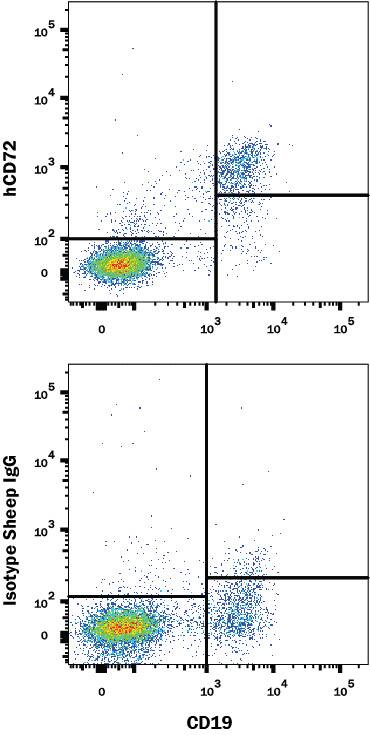Human CD72 Antibody
R&D Systems, part of Bio-Techne | Catalog # AF5405

Key Product Details
Species Reactivity
Human
Applications
Flow Cytometry, Western Blot
Label
Unconjugated
Antibody Source
Polyclonal Sheep IgG
Product Specifications
Immunogen
Mouse myeloma cell line NS0-derived recombinant human CD72
Arg117-Asp359
Accession # P21854
Arg117-Asp359
Accession # P21854
Specificity
Detects human CD72 in direct ELISAs.
Clonality
Polyclonal
Host
Sheep
Isotype
IgG
Scientific Data Images for Human CD72 Antibody
Detection of CD72 in Human PBMCs by Flow Cytometry.
Human peripheral blood mononuclear cells (PBMCs) were stained with either (A) Sheep Anti-Human CD72 Affinity-Purified Polyclonal Antibody (Catalog # AF5405) or (B) Sheep IgG Isotype Control (Catalog # 5-001-A) followed by anti-Sheep IgG APC-conjugated Secondary Antibody (Catalog # F0127) and Mouse Anti-Human CD19 PE-conjugated Monoclonal Antibody (Catalog # FAB4867P). View our protocol for Staining Membrane-associated Proteins.Applications for Human CD72 Antibody
Application
Recommended Usage
Flow Cytometry
0.25 µg/106 cells
Sample: Human PBMC
Sample: Human PBMC
Western Blot
0.1 µg/mL
Sample: Recombinant Human CD72 (Catalog # 5405-CD)
Sample: Recombinant Human CD72 (Catalog # 5405-CD)
Formulation, Preparation, and Storage
Purification
Antigen Affinity-purified
Reconstitution
Reconstitute at 0.2 mg/mL in sterile PBS. For liquid material, refer to CoA for concentration.
Formulation
Lyophilized from a 0.2 μm filtered solution in PBS with Trehalose. *Small pack size (SP) is supplied either lyophilized or as a 0.2 µm filtered solution in PBS.
Shipping
Lyophilized product is shipped at ambient temperature. Liquid small pack size (-SP) is shipped with polar packs. Upon receipt, store immediately at the temperature recommended below.
Stability & Storage
Use a manual defrost freezer and avoid repeated freeze-thaw cycles.
- 12 months from date of receipt, -20 to -70 °C as supplied.
- 1 month, 2 to 8 °C under sterile conditions after reconstitution.
- 6 months, -20 to -70 °C under sterile conditions after reconstitution.
Background: CD72
References
- Nykimbeng-Takwi, E. and S.P. Chapoval (2011) Immunol. Res. 50:10.
- Von Hoegen, I. et al. (1990) J. Immunol. 144:4870.
- Nakayama, E. et al. (1989) Proc. Natl. Acad. Sci. 86:1352.
- Alcon, V.L. et al. (2009) Eur. J. Immunol. 39:826.
- Ishida, I. et al. (2003) Int. Immunol. 15:1027.
- Kataoka, T.R. et al. (2010) J. Immunol. 184:2468.
- Van de Velde, H. et al. (1991) Nature 351:662.
- Luo, W. et al. (1992) J. Immunol. 148:1630.
- Kumanogoh, A. et al. (2000) Immunity 13:621.
- Kumanogoh, A. et al. (2005) Int. Immunol. 17:1277.
- Li, D. H.-H. et al. (2008) Arthritis Rheum. 58:3192.
- Wu, H.-J. et al. (2001) J. Immunol. 167:1263.
- Mizrahi, S. et al. (2007) PLoS ONE 9:e818.
Alternate Names
CD72, Ly-19.2, Ly-32.2, Lyb-2
Gene Symbol
CD72
UniProt
Additional CD72 Products
Product Documents for Human CD72 Antibody
Product Specific Notices for Human CD72 Antibody
For research use only
